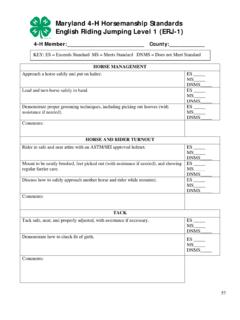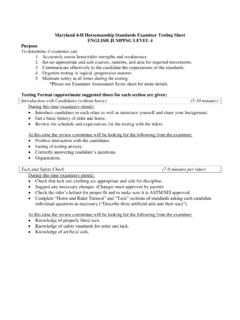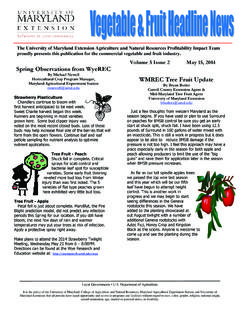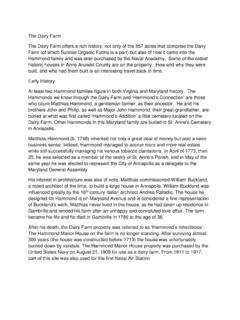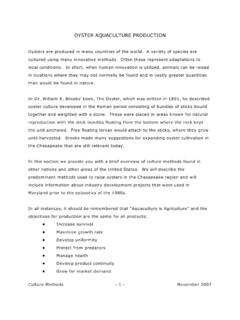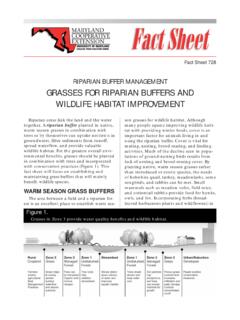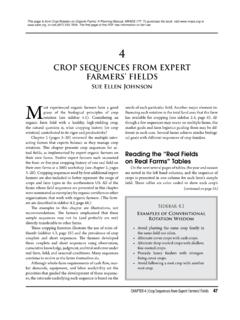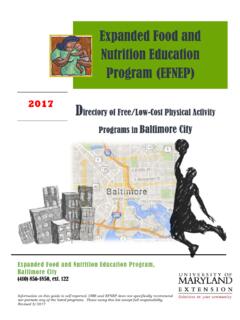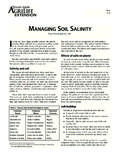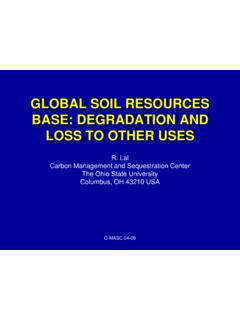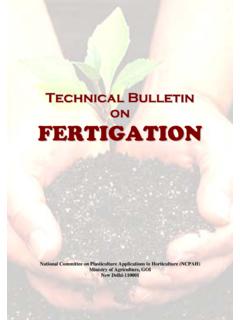Transcription of HG 42 2013 Soil Amendments and Fertilizers
1 1are nitrogen (N), phosphorus (P), and potassium (K). Fertilizers are labeled with a three number analysis corresponding to N, P, and K. It tells what percentage of the net weight is actually composed of these three nutrients. A fertilizer containing all three nutrients is a balanced fertilizer. A 50-lb. bag of 10-6-4 fertilizer will contain 5 lb. of nitrogen (N), 3 lb. of phosphate (P2O5), and 2 lb. of potash (K2O). (Phosphate and potash are the available forms of phosphorus and potassium respectively.) Some common N-P-K analyses of inorganic, granular Fertilizers are 10-6-4, 5-10-5, and 10-10-10. Plants also require the secondary nutrients: calcium, magnesium, and sulfur.
2 Plus they need very small amounts of micronutrients: boron, copper, chlorine, iron, manganese, molybdenum, and zinc. These latter, plus a few others, are referred to as trace or chemical Fertilizers are typically less expensive (per pound of nutrient) and more readily available for plant growth than organic Fertilizers . However, organic Fertilizers often supply other nutrients in addition to N-P-K release nutrients slowly over the growing season, and may double as soil and soil Amendments are a wide array of materials added to soils to improve plant growth. They can be organic, such as bone meal, or inorganic, such as 10-10-10 fertilizer. Some must be purchased, while others are free for the taking from your landscape.
3 Many are dual purpose they serve as both Fertilizers and soil Amendments are anything mixed into topsoil to promote healthy plant growth. They function in a number of ways. For example, they may change the pH of soil or supply nutrients. Fertilizers are primarily valued for their ability to supply nutrients. Plants use these nutrients to make components for plant growth such as proteins and sub-set of soil Amendments , soil conditioners, like composted horse manure, improve soil structure by binding soil particles into larger aggregates. This increases the amount of pore space and enhances air exchange, water movement, and root the many homegrown and retail products available, the wise gardener selects those that most closely address a need while providing the best value for the money.
4 Ask yourself if it makes sense to buy a fertilizer or amendment that hs traveled thousands of miles when local alternatives are available. FERTILIZERSThe main chemicals that must be supplied to plants are called primary nutrients. Those required in the greatest amounts Feed The soil First!The surest way to improve plant growth is the regular incorporation of organic matter such as composted yard waste. Organic matter improves soil structure, slowly releases nutrients, and increases beneficial microbial that appear in italics are trade names. Listed products are only examples and not endorsments. Read All Product Label Instructions Before You Open the Bag!*Materials with an (*) are considered acceptable by organic !
5 ! Wear gloves and a dust mask when handling caustic or finely powdered materials. These include hy-drated and burnt lime, perlite, vermiculite, and peat moss. Take similar precautions with bonemeal, fresh manure, and mulch. For more information on this and other topics visit the University of Maryland Extension website at Amendments and Fertilizers Fertilizing Guidelines Included by Plant Group HG 4220132 Some Fertilizers can be absorbed by plants immediately upon application. These are known as quick release or highly soluble Fertilizers . They are useful when rapid results are required. They come in liquid or powder form and are applied to root zones or sprayed directly on foliage.
6 Slow release Fertilizers , such as Osmocote and sulfur-coated urea, make nutrients available in small amounts over an extended period. Fertilizer stakes or tablets placed in root zone soil are also slow release formulations. However, salt accumulation resulting in root burn, can occur immediately adjacent to these latter often target specific plant needs. For instance, starter Fertilizers specially formulated for seedlings and transplants, are high in phosphorus to foster root OF Fertilizers Alfalfa meal*: typically 3-5% organic nitrogen (3-1-2). May contain ethoxyquin, a preservative, to keep it sulfate: a dry fertilizer which is 21% N, plus sulfur. Very acidic, especially suitable for blueberries and azaleas, which require the ammonium form of nitrogen.
7 Mix into soil to prevent loss of nitrogen to meal*: readily available nitrogen, typically 10-12%. Lasts about 2 months. May help repel deer and rabbits when top-dressed around plants. Bone meal*: steamed ground bone high in phosphate. Sample analysis (1-11-0) or (5-12-0). Especially good for bulbs and root crops. Contains 15-22% calcium , plus trace elements. Lasts 6 to 12 months. Boron*: micronutrient. Can be toxic to plants if applied in excess. Often applied by fruit growers to prevent fruit pitting and rot disorders. Deficiencies are most likely to occur on sandy soils. Incorporate 6-7 tablespoons of Borax per 1,000 sq. ft. of vegetable garden area each spring where soils are iron*: Chelated iron is applied to the folliage of plants suffering from iron chlorosis (yellowing from iron deficiency.)
8 Chelate means claw in Greek. Chelated elements are combined with compounds that hold them in solution, making them available for plant uptake through roots or leaves. Compost tea*: ordinarily homemade from steeping compost in a bucket of water (5 parts water to 1 part compost by volume) for 1-3 days, then straining and applying the brew to plants. Make compost tea using composted yard waste (leaves, grass clippings, etc.) or vermicompost (worm compost). Do not use farm animal manure compost. Good method for applying soluble nutrients directly to foliage or roots during the early part of the growing season when nutrients from soil organic matter are not readily available.
9 Corn gluten*: a natural pre-emergent herbicide. Apply in spring as a top-dressing to help control crabgrass and some weed species. It adds some organic matter and nutrients to the soil (10-1-1). Cottonseed meal*: a slow release fertilizer high in nitrogen, that also adds organic matter (6-2-1). Lasts 6 months to 1 year. Epsom salts*: magnesium sulfate, a highly soluble form of magnesium and sulfur. Can be used as a foliar spray for speedier results. Makes melons sweeter. Does not prevent blossom-end products*: formulations range from fish powder (9-1-1), to fishmeal emulsion (5-1-1). Contain many valuable micronutrients. May have strong fishy smell. Greensand*: a naturally occurring iron-potassium silicate (also called glauconite) with the ability to absorb 10 times more moisture than ordinary sand.
10 It contains marine potash, silica, iron, magnesium, and lime, plus up to 30 other trace minerals. Dual ability to bind sandy soils and loosen clay soils. Potassium (5-7 %) released very slowly over 4 to 5 years. Slightly acidic. Guano*: decomposed manure, usually of bat or seabird origin, was the first commercial fertilizer sold in the Desert bat guano escapes leaching in caves, preserving its nutrients. Seabird guano recycles marine trace elements. Valued for fast release and high N analysis (10-3-1). Suggested use is as a potting soil additive. Foliar Fertilizers are applied directly to the upper and lower leaf surfaces. Plants take up nutrients more efficiently through leaves than through roots.
